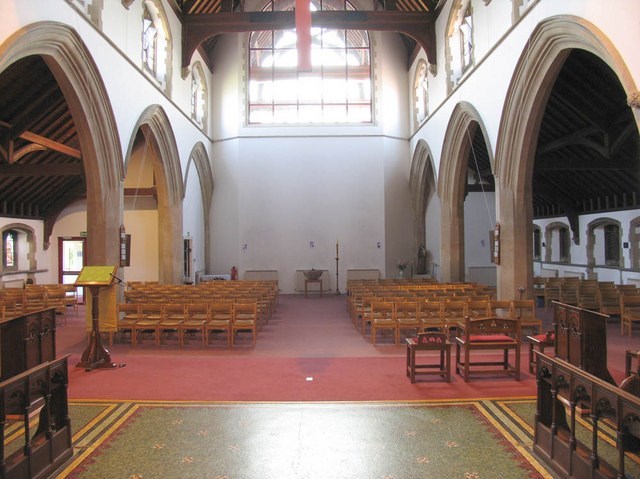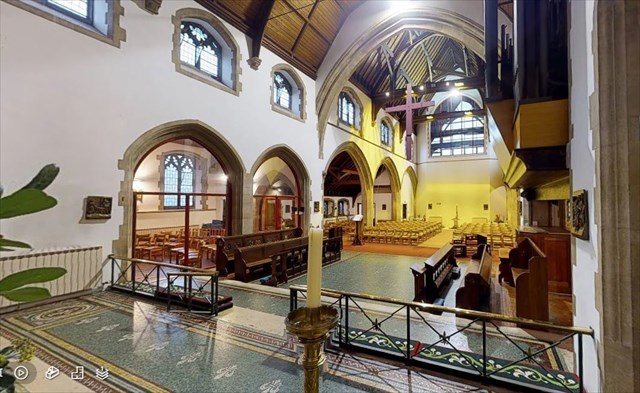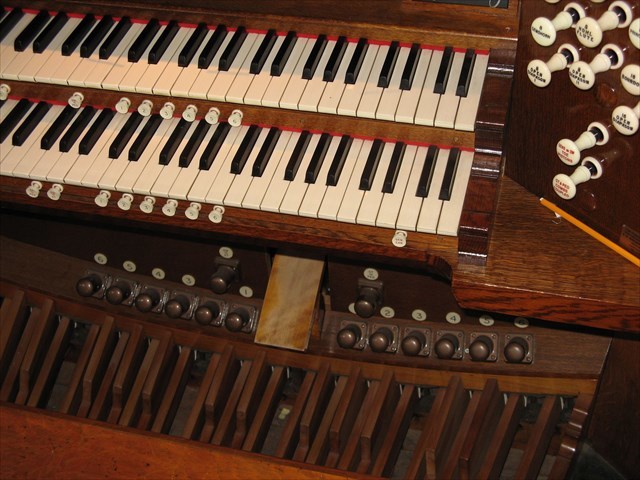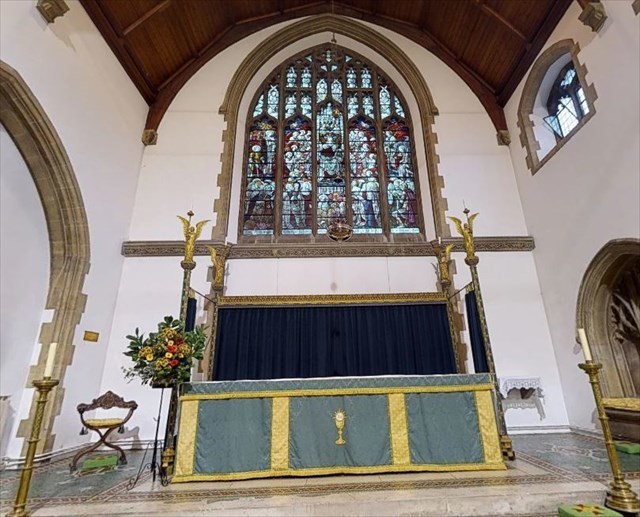Church Micro 7801 . . . Raynes Park - St Saviour

The cache, a camo-taped magnetic sample tube, is hidden near St Saviour's, a Church of England church in the parish of Raynes Park, Diocese of Southark. Parking should be available nearby in one of the side-streets off the main road.
Step 1: at the posted coordinates you will be standing in front of the Foundation Stone which records that the stone was laid on 2A July 1905 which was the Bth year after the creation of the St Saviours Mission.
Step 2: move the short distance across to N 51 24.340 W 0 13.772 the location of a wooden bench in the memory of John Cock who passed away on 18.06.0C who was the church treasurer for over D0 years
Step 3: head back to N 51 24.320 W 0 13.780 from where you can see E other benches along the church walls.
Step 4: now go back outside the church grounds to N 51 24.324 W 0 13.761 where you will note that the large green vertical number on the lamp-post is 0F2
Step 5: just behind the lamp-post is the church notice board which has two telephone numbers on it. The last digit of the lower (landline) number is G
The cache is hidden at:
N 51 24.(A+F)(D-2)(F+G) W 0 13.(C-D)(A+E)(B+1)


The 2011 population of this parish was 9,000, with a high proportion of Roman Catholics because of an influx of Eastern Europeans latterly and close proximity of Catholic Schools around Wimbledon. The congregation averages 30-35 adults + 5-7 children. 50% are 65 or over, another 25% are 40 or over and the remaining 25% are young families.
 The architect was the distinguished Arthur C Blomfield, son of Sir Arthur Blomfield, the architect of the Royal College of Music, and grandson of Charles James Blomfield, the famous Anglican Bishop of London, who initiated a programme of new church construction in the capital.
The architect was the distinguished Arthur C Blomfield, son of Sir Arthur Blomfield, the architect of the Royal College of Music, and grandson of Charles James Blomfield, the famous Anglican Bishop of London, who initiated a programme of new church construction in the capital.
It was the first new church to be built in the Diocese of Southwark (inaugurated 1905) and replaced an small iron structure which had served as a temporary church. If it been completed as originally planned, it would have had a huge tower over the entrance and a cathedral-like nave of six bays. The view from the railway would have been stunning. The choir, Lady Chapel and first four bays of the nave were built, with a temporary west wall, in 1905-1908. Unfortunately, in the financially-constrained period between the wars, the church was never completed.
It was consecrated on 14 July 1906 by the Bishop of Southwark, and renovated in 1989 when the rear  ground to the west of the church was sold to build Warden Assisted Housing. The rear of the church was also refitted with a narthex, hall and upper room with lift, and on the north side an extension was built providing kitchen, toilets, storage and a corridor to the vestries.
ground to the west of the church was sold to build Warden Assisted Housing. The rear of the church was also refitted with a narthex, hall and upper room with lift, and on the north side an extension was built providing kitchen, toilets, storage and a corridor to the vestries.
The church is light, spacious, well-heated, fully carpeted with 175 individual chairs that can be placed in any configuration. As usual, the altar is the focal point for the congregation and above this on the east wall there is a fine stained glass window, and smaller stained glass windows above the end of the south and north aisles.
To the left of the nave there is a small Remembrance Chapel where candles can be lit and the Remembrance Book is kept. To the right of the nave is the Lady Chapel where smaller more intimate services take place. At the back of the church there is a statue of Our Lady which is well-used for personal prayers and to light candles, and in the centre of the back of the church is a font for baptisms.
 The organ was built in 1907 by the prestigious organ-builder William Hill the work being directed by the late founder's grandsons, Walter and Arthur. At first, and like the church, it was only partially constructed, allowing for the work to be completed when funds became available. Much of the house-style established by William was retained in their instruments, including the light, fluty, sound of the chorus work and the rich, rather French, reeds.
The organ was built in 1907 by the prestigious organ-builder William Hill the work being directed by the late founder's grandsons, Walter and Arthur. At first, and like the church, it was only partially constructed, allowing for the work to be completed when funds became available. Much of the house-style established by William was retained in their instruments, including the light, fluty, sound of the chorus work and the rich, rather French, reeds.
The instrument provided for the church was pretty basic, with many stops missing, hardly any casework, and a plank where the third manual was intended to go. Nevertheless, both the mechanism and the pipework were of excellent quality, in spite of being made on the assumption that the church would, one day, be rather larger than it actually is. As mentioned in relation to the church building itself, financial constraints at the time meant there was no possibility of any money being spent on the organ. In any case, the instrument was understood to be of high quality, albeit incomplete. Though no-one realised it, therein lay its salvation. Few new organs were built in England between 1918 and 1960, for economic reasons, resulting in much tinkering with existing instruments, in a misguided attempt to bring them up to date. Many Victorian and Edwardian organs were mutilated, while this one was left almost exactly as its maker intended.
The instrument gave 91 years service before major work was necessary, a tribute to the craftsmanship of 1907. In the meantime, the wooden halls to the rear of the church had become unsafe. In 1989, it was decided to sell the land on which they stood, allowing the present hall and upper room to be constructed and the building to be made permanent, thus opening the way for work on the organ.
In 1998, with funds raised by parishioners and a large donation, it was completed as a two‑manual  instrument by FH Browne & Sons, of Canterbury. The worn-out first stage of the old action was replaced with a solid-state system, freeing space for the Chapel of All Souls, but the original second stage, of the Barker lever type, still works well. It is not only a superb liturgical instrument, but also suitable for a wide repertoire of organ music. More details of the work done on the organ and its full specification is given on the church web-site.
instrument by FH Browne & Sons, of Canterbury. The worn-out first stage of the old action was replaced with a solid-state system, freeing space for the Chapel of All Souls, but the original second stage, of the Barker lever type, still works well. It is not only a superb liturgical instrument, but also suitable for a wide repertoire of organ music. More details of the work done on the organ and its full specification is given on the church web-site.
It was completely renovated in 1996 and regularly used for organ recitals, concerts, and for choral performances by a local choral society - the West Barnes Singers.
The main hall attached to the church is used for a wide variety of community events and private functions, including Tai Chi, Chi Combat, guitar exams, and line dancing! It also serves as a Polling Station for various elections as required by London Borough of Merton.
At the east end of the grounds is a listed WW1 War Memorial which is due to be renovated to restore the 97 carved names, and a listed Holm Oak tree. To the south of the church is a large grassed area and car park. A small group of church members maintain the grounds and Church.
If you would like to add to the Church Micro series yourself then please look here http://churchmicro.co.uk/
There is also a Church Micro Stats & Information page that can be found at http://www.15ddv.me.uk/geo/cm/index.html